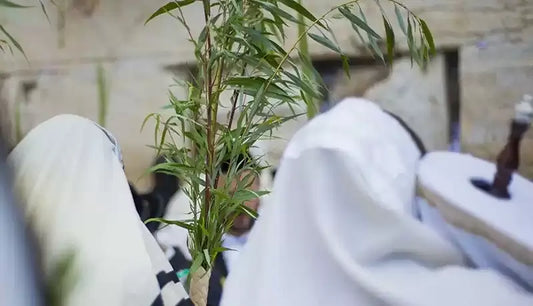Rabbi Hayim Asher Arking
Rabbi Ezra Ghodsi
What is Hosha'na Rabba?
There are three days in the calendar designated for good judgment: Rosh Hashana, Yom Kippur, and Hosha'na Rabba. A judge can sign a court order, but it will only go into effect once it is handed over to the clerk. On Hosha'na Rabba, decisions made on Rosh Hashana and Yom Kippur are sent out to be delivered. We can, on this day, beseech Hashem, the Judge, to reverse His decision before He hands the decrees over to His 'clerks'.
On each day of Sukkot, we walk around the Torah with our lulav and Etrog in hand, asking Hashem “hosha'na - please bring salvation and goodness throughout the year”. On the last day of Hol Hamo'ed Sukkot, as this is the seventh day that we encircle the Torah and the climax of Sukkot, we ask for salvation and help from Hashem in many ways, namely, regarding the crops and rain. This is why the day is called Hosha’na Rabba; hosha = save, na = please, rabba = great.
In the times of the Bet Hamikdash, circling the mizbeach with aravot was performed every day of Sukkot once, and on the seventh day – Hosha'na Rabba - they would walk around seven times. This Mitsvah was so important, that it was even performed on Shabbat.
What special practices are done on this day?
1) We study the tikkun throughout the night, reviewing the entire Sefer Devarim before midnight, and then reciting Tehillim with excerpts from the selihot. We also recite Hashem Hu HaElokim in Shaharit, as we do during the High Holidays.
2) After hallel, we circle the Torah seven times reciting the hosha'not prayers, which are all-encompassing as will be detailed.
3) After the Tefillah, we take five aravot in hand, and bang them against the dirt. Afterwards, it is customary to return to the Bet Haknesset, open the hechal, and recite Nishmat Kol Hai until (but not including) the blessing at the end of Yishtabah.
What is the meaning of the extra hosha'not prayers?
We go around the Torah seven times with our lulav and etrog asking "hosha'na" – please help – while reciting Selihot with each segment highlighting the merits of one of the seven ushpizin. The first circuit corresponds to Avraham, the second to Yishak, etc.
After the seventh circuit, we recite prayers which build upon the refrain of ‘hosha'na’, adding more and more levels of beseeching, reaching a total of ten steps:
1. Hosha'na - we open with the core prayer, asking Hashem to save us, just as we have done every day of Sukkot, and during all the previous circuits of the day.
2. Anna hoshia na - we ask for the rebuilding of the Bet Hamikdash,
3. Ani VaHu hoshia na - we ask for salvation from oppression, in the merit of the four species that correspond to parts of our body (etrog = heart; lulav = spine; hadasim = eyes; aravot = lips).
4. Anna El na Hosha'na v'hoshia na - we ask for Hashem to grant bounty of produce (mentioning by name: wheat, barley, spelt, oats, rye, rice, millet, beans, lentils, olive trees and its oil, grapes, figs, pomegranates, walnuts, dates, apples, pistachios, almonds, chestnuts, carob, mini fruit, peaches, berries, pears, Etrog, and all types of vegetables and grains.)
5. Anna El na hosha'na v'hatsliha na - we ask to be transplanted back in Eretz Yisrael with all its blessings of bounty and water.
6. Anna El na hosha'na v'harviha na Avinu attah - We invoke the merit of Noah, Avraham, Yishak, Yaakov, and Moshe Rabbenu mentioning how they found favor in the Eyes of Hashem, and request in their merit that Hashem should not withhold blessed rainwater.
7. Anna El na refa na, selah na, hasha'na v'hoshia na, Avinu attah - we invoke the merit of Noah, Avraham, Yishak, Yaakov, Moshe, and Aharon, requesting that our prayers today be of glory and praise; cherished and powerful enough to carry us throughout the year.
8. Hoshienu Moshi'enu ki lecha enenu ulecha lishuatenu – When we begin praying for rain (switching back to ‘morid hageshem’) on the upcoming day of Shemini Aseret, we ask for a year of light, blessing, etc. in Aleph Bet order. Here we pray corresponding only to the first four letters, in a precursor of the upcoming prayers on Shemini Aseret.
9. Ha'El l'mosha'ot am nosha BAdonai, hosha'na behasdicha meyahalim l'Adonai, ki lishuatecha kivinu Adonai, Adam u'behemah toshia Adonai, ki lishuatecha kivinu Adonai. We declare that it is our yearning for Hashem’s salvation, which causes us to find favor in His eyes.
10. We then culminate by beseeching Hashem to send Eliyahu HaNavi to herald the final redemption, with the declaration of - kol mevaser, mevaser v'omer.
After musaf, one takes five aravot in a bundle and goes outside to strike them against the dirt.
What is the meaning of banging aravot against the dirt?
The shape of the aravot represents the lips, hinting to the sin of Lashon Hara. They also represent the non-virtuous Jews, since they have no scent or taste. Throughout the month of Tishri and Sukkot, we had many mitsvot surrounding and protecting us. As we culminate the 'season' of mitsvot, we hit the aravot against the dirt, the food of the snake who is the paradigm of Lashon Hara. By doing so, we request that all who speak negatively of us – and the Satan in particular – be silenced.
Can I use the aravot from my lulav?
Although halachically one can use the ones from his lulav, it is preferable not to. Even if one does not have aravot, it is better to reuse someone else’s bundle, so long as most of the leaves are still attached, than to use the ones from the lulav. (יחוה דעת ג' מ”ח).




